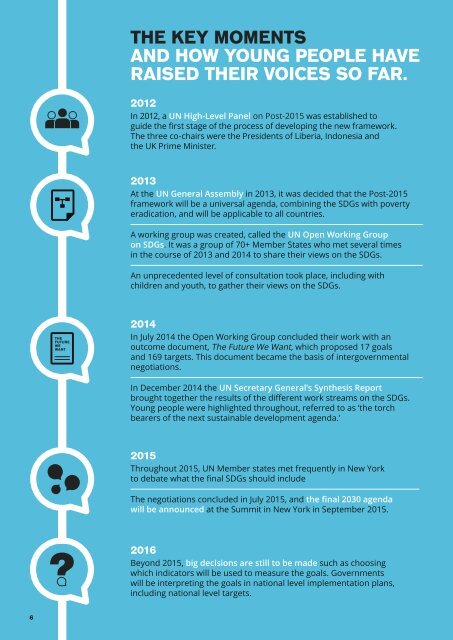WHAT’S MISSING IN THE SDGS AND WHAT CAN YOU DO ABOUT IT?
1OwIKgK
1OwIKgK
You also want an ePaper? Increase the reach of your titles
YUMPU automatically turns print PDFs into web optimized ePapers that Google loves.
<strong>THE</strong> KEY MOMENTS<br />
<strong>AND</strong> HOW <strong>YOU</strong>NG PEOPLE HAVE<br />
RAISED <strong>THE</strong>IR VOICES SO FAR.<br />
2012<br />
In 2012, a UN High-Level Panel on Post-2015 was established to<br />
guide the first stage of the process of developing the new framework.<br />
The three co-chairs were the Presidents of Liberia, Indonesia and<br />
the UK Prime Minister.<br />
2013<br />
At the UN General Assembly in 2013, it was decided that the Post-2015<br />
framework will be a universal agenda, combining the SDGs with poverty<br />
eradication, and will be applicable to all countries.<br />
A working group was created, called the UN Open Working Group<br />
on SDGs. It was a group of 70+ Member States who met several times<br />
in the course of 2013 and 2014 to share their views on the SDGs.<br />
An unprecedented level of consultation took place, including with<br />
children and youth, to gather their views on the SDGs.<br />
2014<br />
In July 2014 the Open Working Group concluded their work with an<br />
outcome document, The Future We Want, which proposed 17 goals<br />
and 169 targets. This document became the basis of intergovernmental<br />
negotiations.<br />
In December 2014 the UN Secretary General’s Synthesis Report<br />
brought together the results of the different work streams on the SDGs.<br />
Young people were highlighted throughout, referred to as ‘the torch<br />
bearers of the next sustainable development agenda.’<br />
2015<br />
Throughout 2015, UN Member states met frequently in New York<br />
to debate what the final SDGs should include<br />
The negotiations concluded in July 2015, and the final 2030 agenda<br />
will be announced at the Summit in New York in September 2015.<br />
2016<br />
Beyond 2015, big decisions are still to be made such as choosing<br />
which indicators will be used to measure the goals. Governments<br />
will be interpreting the goals in national level implementation plans,<br />
including national level targets.<br />
6


